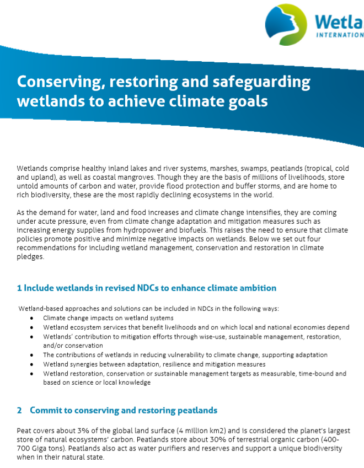
Valuing Wetlands in climate and biodiversity agendas: recommendations for climate pledges
-
Climate mitigation and adaptation
-
Coastal resilience
With the UNFCCC COP25 just around the corner, leaders across the world are assessing and finalising the climate strategies that will be implemented in 2020. These must reflect the speed, scale and ambition needed to keep the global temperature between 1.5-2°C above pre-industrial levels.
Currently, as highlighted by the UNEP emissions gap report out this week, these Nationally Determined Contributions (NDCs) are still falling far short of the ambition needed to keep warming below 2C. At the September 2019 UN Climate Action Summit in New York, many small and medium-sized countries sent a clear signal that they will strengthen their commitments next year. Almost 70 countries have indicated that they intend to enhance their NDCs.
After a year of pivotal scientific reports on land use, the cryosphere and biodiversity, it’s increasingly clear that climate change and biodiversity loss must be addressed together, making ecosystems approaches crucial. But this goes well beyond simply planting trees.
As described below, re-wetting degraded peatlands, preserving permafrost areas and restoring mangroves as green infrastructure are vital to not only for reducing greenhouse gas emissions, but to developing resilience in the face of the growing impacts of climate change.
The need to conserve and restore peatlands
Peat covers about 3% of the global land surface (4 million km2) and is considered the planet’s largest store of natural ecosystems’ carbon. Peatlands store about 30% of terrestrial organic carbon (400-700 Giga tons). Peatlands also act as water purifiers and reserves and support a unique biodiversity when in their natural state.
But, some 15% of the world’s peatlands have been drained or transformed for crop agriculture, forestry and grazing, which leads to oxidation and the release of the carbon stored in peat. Degrading peatlands contribute at least 5% to the total global anthropogenic emissions despite covering only 3% of the global land surface.
The world’s stock of tropical peat is estimated to be as much as 350 billion tonnes, making a global total of more than 800 billion tonnes – equivalent to 20 years of carbon emissions from burning fossil fuels. The discovery of vast peat stores across the Amazon and Orinoco rivers, the Congo, Sudd and Inner Niger Delta – in other words, potential ‘carbon time bombs’—provides important new impetus for the protection of tropical wetlands against land use change and degradation. The tropical alpine peatlands are water towers for vast areas vulnerable to droughts.
Local economy and livelihood approaches such as paludiculture (sustainable management of peatlands through wet agriculture), integrated mangrove-aquaculture and other agroecosystems provide sustainable alternatives that prevent severe wetland degradation.
The need to restrict land-use change in permafrost areas to maintain vast carbon stores
Permafrost covers 25% of the terrestrial part of the globe concentrated in the Arctic and high mountains. A quarter of all the carbon stored in the world’s wetlands, soils and forests is estimated to be found in the frozen peatlands of Western Siberia though the greatest quantities are in the southern areas most susceptible to thawing. Canada, Alaska and northern Scandinavia have significant permafrost reserves. Many countries do not recognise presence of permafrost within their borders.
Permafrost is distributed in high altitudes and high mountains and is closely connected to peatlands. Use of land where there is permafrost, such as drilling, mining, fragmentation through road and pipelines infrastructure and overgrazing destroy organic soil and peat layer cover protecting permafrost areas and causes its thawing. This is enhanced and accelerated by climate change. Unfortunately, few countries acknowledge the role of land use change in permafrost thawing and instead, attribute it simply to the impacts of climate change.
The total store of carbon accumulated in permafrost peat is estimated at around 1700 billion tonnes, twice the amount in the atmosphere. If land use change and global warming together accelerate thawing, this carbon timebomb could bubble up — as carbon dioxide if there is oxygen present, or as methane if not – and cause an unstoppable feedback loop of accelerated emissions and warming.
As permafrost thaws, non-desirable and potentially toxic substances, for example mercury, are released into water systems, both locally and globally.
Shift from grey to green infrastructure by ‘building with nature’
While most national climate pledges include adaptation measures in the water sector, these are largely focused on grey infrastructure. Despite the potential gains from nature-based solutions, they currently attract less than 1% of total investments into water resource management.
While 65% of the climate pledges stress the vulnerability of the water sector to climate change and almost 80% include adaptation measures in the water sector, a limited number of NDCs identify the need to protect and restore water ecosystems.
Building with Nature is a new way of planning, designing and realising infrastructure for coastal, river and delta management by leveraging nature’s protecting functions from increasing climate disasters. It is a way of designing water infrastructure so that it works with nature rather than against it and is often more cost-effective and affordable than traditional hydraulic engineering approaches.

